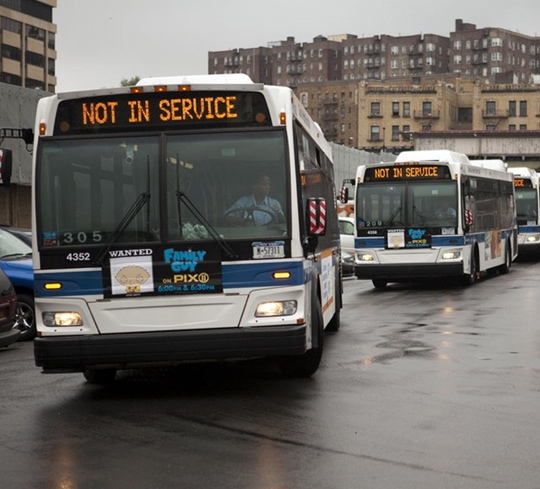 In a case that should shock the conscience of all New Yorkers, five people held up a bus in Brooklyn a few days before Christmas and threatened to kill the driver with a gun. According to the Sheepshead Bites Blog, they soon jumped off, and onto another bus, and the police were able to make arrests because of a passenger’s 911 call.
In a case that should shock the conscience of all New Yorkers, five people held up a bus in Brooklyn a few days before Christmas and threatened to kill the driver with a gun. According to the Sheepshead Bites Blog, they soon jumped off, and onto another bus, and the police were able to make arrests because of a passenger’s 911 call.
But this isn’t the shocking part — any big city will have some depraved citizens breaking the law.
No, the shocking part is that, according to the article, the driver of the bus, employed by the New York City Transit Authority, was prohibited by its own regulations from calling the police.
According to the article a NYS Assemblyman called Transit to inquire…and the part about prohibitions from calling the police just leaped off the page at me:
[Assemblyman Rory] Lancman’s office also noted that it’s fortunate a bystander on the bus called the police, as MTA internal directives bar MTA employees from calling the police directly. Instead, they are ordered to inform their supervisors, and MTA representatives respond to the scene themselves, and only inform the police if they feel it’s warranted. It was noted that had the bystander not called, police would not have been able to pursue the suspects after they boarded another bus.
So, four questions to ponder:
- Does this policy preventing bus drivers from calling the police really exist?
- If it does, what are the ramifications with respect to the injured?
- What are the ramifications for civil suits?
- Is it legal?
Answer: Yes, it appears to be true. It puts people’s lives at risk. It prevents proper police investigation. And no, it does not appear to be legal.
I turned to one of my friends, David Roth (of Roth & Roth) to give me the goods on this, and see if he had more than Assemblyman Lancman. Roth has had his fair share of cases against Transit, and has lectured to other lawyers on the subject. And, he’s investigated this very issue.
Now here’s the scoop, according to a recent deposition that Roth took: The bus driver is not permitted to directly call the police. The driver has a radio and it only goes one place — to dispatch. So if someone has a heart attack or is bleeding to death after an accident, there is an automatic delay as the story first gets told to dispatch and then dispatch gives the story secondhand to 911. The same is true for a criminal act. The story must get told twice with the risk of facts getting muddled (or time wasted) along the way. And 911 doesn’t have direct access to bystanders on the scene to get additional medical information, such as a medical history, to assist the EMTs racing to the scene.
I’ve discussed this type of institutional negligence before: In 2007 a school was found to have a rule that prohibited the staff from calling 911 in an emergency, forcing delays as a problem winds its way through bureaucracy: How To Kill A Student: A Lesson From A Queens High School.
But that risk to life and limb isn’t the sole reason to write this piece. You see, when dispatch calls 911 after an accident, then dispatch will tell 911 to only send an ambulance, and not the police. The police are summoned for criminal actions. And Transit sends its own supervisor over to the accident to “investigate.”
Why is that important, and why did I put investigate in quotes? Because if the police are called after an accident then they take the names of witnesses and look for evidence. But if a TA supervisor is called, instead of the police, then witnesses scatter due to the delay (or perhaps because the Supervisor lets them know they can, you know, just leave) and it makes it more difficult for the injured passenger(s) to bring the TA to account if the driver was at fault.
But according to Roth, this runs afoul of the law’s requirement for the vehicle operator to contact the police right away:
All operators of motor vehicle’s are required to contact the police as soon as practicable according to VTL §600 when someone is injured in an accident. This includes buses. Bus operators for the NYCTA and the related agencies are required to call dispatch which is located in East New York and then the supervisors at dispatch call the police.
The TA dispatchers call the ambulance when someone is injured but do not call the police. The dispatchers call the TA road dispatchers who come to the scene to do their own investigation. This has the insidious effect of allowing the TA to sanitize the accident scene and prevent an independent investigation by the police.
Is Roth right that this violates the law? It would appear so. According to VTL §600(2) (a miserably long 159-word run-on sentence):
2. Personal injury a. Any person operating a motor vehicle who, knowing or having cause to know that personal injury has been caused to another person, due to an incident involving the motor vehicle operated by such person shall, before leaving the place where the said personal injury occurred, stop, exhibit his or her license and insurance identification card for such vehicle, when such card is required pursuant to articles six and eight of this chapter, and give his or her name, residence, including street and street number, insurance carrier and insurance identification information including but not limited to the number and effective dates of said individual’s insurance policy and license number, to the injured party, if practical, and also to a police officer, or in the event that no police officer is in the vicinity of the place of said injury, then, he or she shall report said incident as soon as physically able to the nearest police station or judicial officer.
See the highlighted words? When someone is injured, the motor vehicle operator “shall report said incident as soon as physically able.” But the TA doesn’t appear to be doing that, instead reporting first to a dispatcher, and sending a supervisor to the scene. And that supervisor may, or may not, call the police. And that would appear to be a big fat no-no.
Naturally, this is not the face the Transit Authority wants the public to see. They insist on their web site that customer safety is their top concern. They write:
MTA New York City Transit is interested in your safety. In fact, it’s our foremost concern.
So there you have it. The Transit Authority has put in place a policy that stops or delays the police from investigating its accidents by routing everything through dispatch and supervisors,who don’t call police unless a criminal act has occurred. Witnesses then leave, and the TA can then just shrug its shoulders if sued and say the witnesses disappeared before their names could be taken. Sorry, they can say, we don’t have any witnesses except our driver. The others didn’t stick around. Such a shame.
And that policy, in turn, appears not only to violate the law and affect the way Transit Authority cases are litigated in civil matters, but also puts passengers at grave risk when people are injured after an accident. Delay is no friend to the injured, but it is to the Transit Authority.


